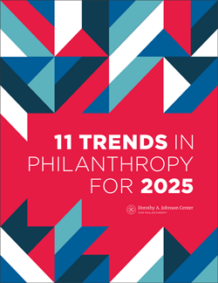What Does the Future of Volunteering Look Like?


 This article was first published in our 11 Trends in Philanthropy for 2025 report. Explore the full report here.
This article was first published in our 11 Trends in Philanthropy for 2025 report. Explore the full report here.
Want the latest trends, research, and more delivered right to your inbox? Subscribe to the Johnson Center email newsletter.
The marked decline in the number of households that give to charity in the U.S. has dominated headlines for several years. But this phenomenon is coupled with another, potentially equally disruptive and concerning shift for the nonprofit sector: the decline of volunteering.
According to the U.S. Bureau of Labor Statistics (2006), 27.6% of the population aged 16 and over volunteered in 2002 — the earliest date for which BLS data is available. A decade later, in 2012, it was a more-or-less comparable 26.5% (BLS, 2012). By 2019, that number had climbed to 30% (AmeriCorps, 2021). But then, one year into the pandemic, the national rate of volunteering hit a historic low: from September 2020 to September 2021, just 23.2% of Americans participated in formal volunteering (AmeriCorps, 2023).
The good news: AmeriCorps data released in late 2024 showed that number is rebounding. From September 2022 to September 2023, 28.3% of adults aged 16 years and older formally volunteered with an organization — a 5-point increase year-over-year (p. 1).
The Generosity Commission’s 2024 report Everyday Actions, Extraordinary Potential: The Power of Giving and Volunteering provided a comprehensive overview of the trend data concerning declines in both giving and volunteer participation rates — though it was published before the most recent AmeriCorps numbers were released. But the question now is, where do we go from here? What can research tell us about the future of volunteering? How will it be managed, what forms of service will be embraced, and what skills and systems will nonprofits and funders need to prioritize to reverse the slide?
The sector may not be able to use traditional volunteering models to engage Gen Z, and even the millennials before them. As Hager and Brudney (2021) report, “the ‘super volunteer’ of an earlier era who anchored the work life of an organization day-in and day-out for years on end is increasingly rare” (p. 18). Routine, in-person engagements — such as having the same volunteer show up for the same four-hour slot at an information desk week after week — are becoming harder to fill. Instead, the future of volunteering may look more like this:
Bite-Sized Experiences
Hager and Brudney (2021) identified that between 2003 and 2021, volunteers became “more interested in episodic, short-term assignments” (p. 18). Gruber and Deschênes (2024) confirmed this finding and encouraged nonprofits to see its value:
New volunteers seek flexibility and opportunity; they help out when they have time and when the task fits their agenda. Adopting a pragmatic approach to the relationship is crucial for nonprofit organizations. This involves accepting a certain degree of distance to and from these volunteers, who may be less emotionally attached to the organization, and respecting their desire for intermittent engagement. What matters is not their unwavering loyalty but their existing skills. (para. 9)
This shift may be visible in the popularity of platforms like Catchafire and the UK’s OnHand (touted by its creators as “‘the Netflix’ of volunteering” [Clegg, 2024, para. 4]) which offer potential volunteers the opportunity to take on short-term, often project-based volunteer assignments according to their talents, inclinations, and available time. Catchafire (n.d.) has moved from facilitating just over 2,700 volunteer engagements in November 2020 to over 14,000 in November 2024.
Virtual Engagements
Catchafire’s model also illustrates a second characteristic likely to define the future of volunteering: more of it will be virtual. An August 2020 survey conducted by Fidelity Charitable (2021) revealed that only 11% of respondents preferred virtual volunteering to on-site/in-person engagements, but the researchers shared a caveat: “as more nonprofits pivot to offering virtual volunteer opportunities and the variety of options broadens, more volunteers may find virtual roles they prefer” (p. 16).
The pandemic created a natural experiment and an urgency for developing, testing, and launching these offerings. Dietz and Grimm (2023) found that 31.3% of nonprofits said they created “more remote and virtual volunteer opportunities” (p. 36) during the pandemic; 38% of funders also reported they would like to see nonprofits offer more of these kinds of engagements.
AmeriCorp’s 2024 data continued to bear this out: 18% of those individuals who formally volunteered with an organization in the September 2022 to September 2023 period did so entirely online (p. 3).
Shifting the Narrative to Recognize More Informal Giving
According to “Volunteering and Civic Life in America” (AmeriCorps, 2023), while 23.2% of Americans formally volunteered with an organization between September 2020 and September 2021, nearly 51% performed informal acts of service for neighbors, friends, and family. As philanthropy comes to better recognize and account for a diversity of philanthropic forms (Layton, 2022), it will likely serve our sector — and our country — well to shift the narrative on what “counts” as philanthropy and volunteering, specifically. The language of decline and disconnection could breed its own self-fulfilling prophesy, while a different story might encourage different outcomes.
Hager and Brudney (2021) also observed that volunteers will play an irreplaceable role in helping people to reestablish trust with one another and rebuild social fluency post-pandemic, and nonprofits will need to think carefully and creatively about how to engage their volunteers in this work. Thousands of nonprofits depend on a dedicated and skilled pool of volunteers, of course, and many organizations are entirely volunteer-run. That story is worth telling, too.
Declining Together, Rising Together
Moreover, investing in meaningful and effective volunteer engagement and management could well be the key to reversing the decline in charitable giving participation. “When donation rates dwindle overall, those who volunteer maintain their giving behaviors and are more likely to be retained as monetary donors,” according to the GivingPulse Q1 2024 Report (2024, part 5). “When monetary donation rates were at their lowest in Q1 [2024], volunteers made up over half (55%) of donors” (part 5).
This finding reflects the overarching narrative of so many research studies published in the past decade, including the Fidelity Charitable 2014 report, Time and Money: The Role of Volunteering in Philanthropy, Goldseker and Moody’s 2020 Generation Impact study of next-gen major donors, and Dietz’s 2024 report, Social Good and Generosity, from the Do Good Institute. Donors want nonprofits to create more opportunities for their donors to make an impact with their time and talents, as well as their treasure. They want to contribute to strategy, to evaluation, to concrete outcomes; they want their ideas taken seriously. Organizations that can build volunteer programs that include these kinds of engagement opportunities alongside their task-based engagements are likely to thrive.
However, the work to shift our vision and systems for what it means to volunteer will take time and capital — both financial and human — to achieve. Volunteer management — including the staffing, expertise, and systems necessary for operating effective volunteer corps — has long been undervalued and under-resourced in the nonprofit sector.
The results of this under-investment affect both volunteer managers (Bennett, 2022; Smith, 2023; Swift, 2019) and the volunteers themselves. Hager and Brudney (2021) compared their own research from 2003 to the state of the field in 2019 and found that, “on average, nonprofits have not increased their volunteer management capacity” in that time. “As in 2003, a substantial number of nonprofits work on a shoestring, under-valuing volunteers by shortchanging the amount of time, effort, and resources that they devote to support of their volunteers” (p. 18).
While Dietz and Grimm (2023) separately reported that staffing for volunteer management increased slightly from 2003 to 2019 (62% of nonprofits utilizing volunteers had a paid staff person to manage them in 2003, versus 65.2% in 2019), the people in those roles continued to face a dearth of training (p. 10) and actionable research on effective organizational practices (Spinney and Clinton, 2024, p. 2) that could have made their jobs and programs more sustainable — and volunteer cadre larger.
This may be because there is little money available in the sector for studying and supporting effective volunteer programs. The Leighty Foundation (2017) is one of the very few with a stated mission to use grantmaking to advance volunteer management and to help nonprofits expand their capacities to support volunteers. However, new programs like Independent Sector’s Strategic Volunteer Engagement Program (2024), which “aims to transform the future of volunteerism by supporting nonprofits to effectively engage their volunteer networks, and by providing guidance to funders on how to invest in strategic volunteer engagement” (para. 1), are reason for hope.
The people who power this sector — be they paid or volunteer — play a foundational role in supporting civil society and growing organizations’ capacity. But it is also often an unacknowledged and unsupported role: grant funding for salaries and benefits has been scarce and the general public lacks a real understanding of how nonprofits serve communities (Indiana University Lilly School of Philanthropy, 2023). If the sector wants to reverse the tide of declining volunteer rates, it’s going to have to put more of everything — money, people, research, training — into supporting meaningful and sustainable volunteer management.
AmeriCorps. (2021). Key findings from the 2019 Current Population Survey: Civic Engagement and Volunteering Supplement.
AmeriCorps. (2023). Volunteering and civic life in America. https://americorps.gov/sites/default/files/document/volunteering-civic-life-america-research-summary.pdf
AmeriCorps. (2024). Renewed engagement in American civic life. https://americorps.gov/sites/default/files/document/CEV2023_HeadlineReport_11052024_final_508.pdf
Bennett, J. (2022, September 22). Volunteer managers—Are you quietly going about your day, solving problems, and being awesome? Volunteer Match. https://blogs.volunteermatch.org/response-article-why-and-how-charities-should-revive-a-declining-but-vital-resource-…-volunteers
Bureau of Labor Statistics. (2006). Volunteering in the United States, 2002. U.S. Department of Labor. https://www.bls.gov/cps/volun.pdf
Bureau of Labor Statistics. (2012). Volunteering in the United States, 2012. U.S. Department of Labor. https://www.bls.gov/news.release/archives/volun_02222013.pdf
Catchafire. (n.d.). Impact metrics. Retrieved November 18, 2024, from https://www.catchafire.org/impact/metrics/
Clegg, M. (2024). ‘Netflix of volunteering’ eases burden of corporate charity work. Financial Times. https://www.ft.com/content/77af63a8-a25f-4b5a-b817-e025c7c2f754
Dietz, N., & Grimm, R. T. (2023, February). The state of volunteer management: Insights from nonprofit leaders and funders. Do Good Institute, University of Maryland. https://dogood.umd.edu/sites/default/files/2023-02/TheStateofVolunteerEngagement_DGI2023_0.pdf
Dietz, N. (2024). Social connectedness and generosity: A look at how associational life and social connections influence volunteering and giving (and vice versa). Do Good Institute, University of Maryland. https://dogood.umd.edu/sites/default/files/2024-01/FINAL_SocialConnectednessandGenerosity_2024.pdf
Fidelity Charitable. (2021). The role of volunteering in philanthropy. https://www.fidelitycharitable.org/content/dam/fc-public/docs/resources/the-role-of-volunteering-in-philanthropy.pdf
GivingPulse. (2024, January to March). GivingPulse Q1 2024 report. GivingTuesday. https://www.givingpulse.givingtuesday.org/q12024#part5
Goldseker, S., & Moody, M. (2020). Generation impact: How Next Gen donors are revolutionizing giving (updated and expanded edition). Wiley.
Gruber, V., & Deschênes, J. (2024, July 9). The new paradigm in volunteering—And how nonprofits can adapt to “neither-growing-nor-fading” brand relationships. American Marketing Association. https://www.ama.org/2024/07/09/the-new-paradigm-in-volunteering-and-how-nonprofits-can-adapt-to-neither-growing-nor-fading-brand-relationships/
Hager, M. A., & Brudney, J. L. (2021). Volunteer management capacity in America’s charities: Benchmarking a pre-pandemic field and assessing future directions. Arizona State University. https://www.volunteeralive.org/docs/Hager_Brudney_VMC2_2021_brief.pdf
Independent Sector. (2024). Strategic volunteer engagement program. https://independentsector.org/resource/initiative-for-strategic-volunteer-engagement/
Indiana University Lilly Family School of Philanthropy. (2023). What Americans think about philanthropy and nonprofits. https://scholarworks.indianapolis.iu.edu/server/api/core/bitstreams/b5904a8a-5081-42cd-bd44-56740b98fb67/content
Layton, M. (2024). Expanding the definitions of philanthropy and philanthropist. 11 trends in philanthropy for 2022. Dorothy A. Johnson Center for Philanthropy at Grand Valley State University. https://johnsoncenter.org/blog/expanding-the-definitions-of-philanthropy-and-philanthropist/
Leighty Foundation. (2017). Why invest in volunteer engagement? https://www.leightyfoundation.org/volunteer-engagement/invest-volunteer-engagement/
Smith, N. R. (2023, October 12). One of the most difficult jobs in the world: Volunteer engagement. Medium. https://nicolersmith.medium.com/one-of-the-most-difficult-jobs-in-the-world-volunteer-engagement-1a8531deac08
Spinney, S., & Clinton, Y. (2024). Engaging volunteers: A comprehensive literature review. ICF. https://americorps.gov/sites/default/files/document/Literature%20Review%20for%20Volunteer%20Management_0.pdf
Swift, M. (2019, August 7). Whose fault is it that volunteer management is misunderstood? Volunteerplaintalk. https://volunteerplaintalk.com/2019/08/07/whose-fault-is-it-that-volunteer-management-is-misunderstood/
The Generosity Commission. (2024, September 30). Everyday actions, extraordinary potential: The power of giving and volunteering. https://www.thegenerositycommission.org/report/